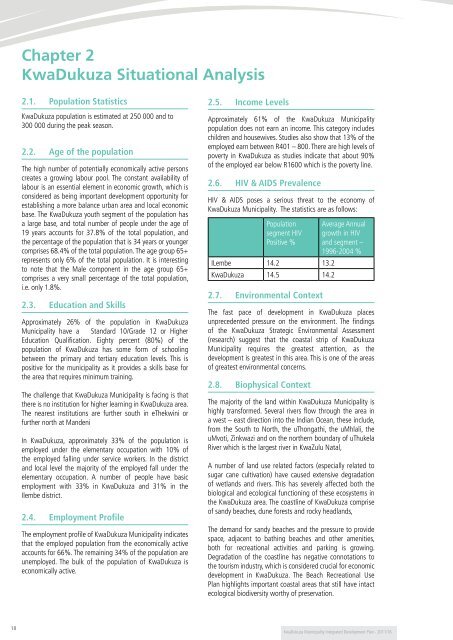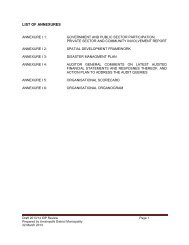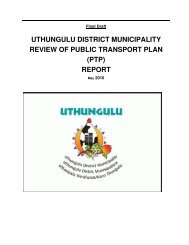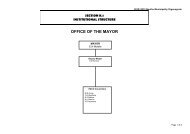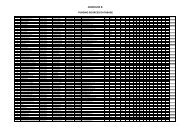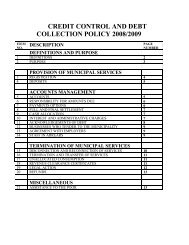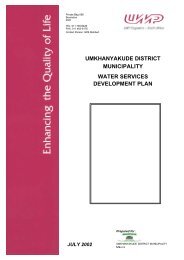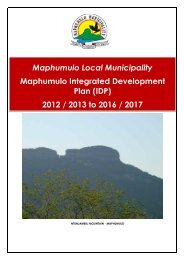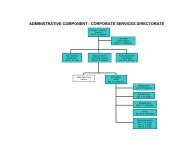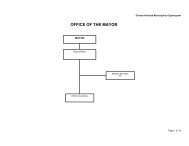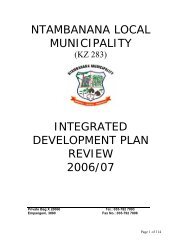Chapter 2KwaDukuza Situational Analysis2.1. Population StatisticsKwaDukuza population is estimated at 250 000 and to300 000 during the peak season.2.2. Age of the populationThe high number of potentially economically active personscreates a growing labour pool. The constant availability oflabour is an essential element in economic growth, which isconsidered as being important development opportunity forestablishing a more balance urban area and local economicbase. The KwaDukuza youth segment of the population hasa large base, and total number of people under the age of19 years accounts for 37.8% of the total population, andthe percentage of the population that is 34 years or youngercomprises 68.4% of the total population. The age group 65+represents only 6% of the total population. It is interestingto note that the Male component in the age group 65+comprises a very small percentage of the total population,i.e. only 1.8%.2.3. Education and SkillsApproximately 26% of the population in KwaDukuzaMunicipality have a Standard 10/Grade 12 or HigherEducation Qualification. Eighty percent (80%) of thepopulation of KwaDukuza has some form of schoolingbetween the primary and tertiary education levels. This ispositive for the municipality as it provides a skills base forthe area that requires minimum training.The challenge that KwaDukuza Municipality is facing is thatthere is no institution for higher learning in KwaDukuza area.The nearest institutions are further south in eThekwini orfurther north at MandeniIn KwaDukuza, approximately 33% of the population isemployed under the elementary occupation with 10% ofthe employed falling under service workers. In the districtand local level the majority of the employed fall under theelementary occupation. A number of people have basicemployment with 33% in KwaDukuza and 31% in theIlembe district.2.4. Employment ProfileThe employment profile of KwaDukuza Municipality indicatesthat the employed population from the economically activeaccounts for 66%. The remaining 34% of the population areunemployed. The bulk of the population of KwaDukuza iseconomically active.2.5. Income LevelsApproximately 61% of the KwaDukuza Municipalitypopulation does not earn an income. This category includeschildren and housewives. Studies also show that 13% of theemployed earn between R401 – 800. There are high levels ofpoverty in KwaDukuza as studies indicate that about 90%of the employed ear below R1600 which is the poverty line.2.6. HIV & AIDS PrevalenceHIV & AIDS poses a serious threat to the economy ofKwaDukuza Municipality. The statistics are as follows:Populationsegment HIVPositive %ILembe 14.2 13.2KwaDukuza 14.5 14.22.7. Environmental ContextAverage Annualgrowth in HIVand segment –1996-2004 %The fast pace of development in KwaDukuza placesunprecedented pressure on the environment. The findingsof the KwaDukuza Strategic Environmental Assessment(research) suggest that the coastal strip of KwaDukuzaMunicipality requires the greatest attention, as thedevelopment is greatest in this area. This is one of the areasof greatest environmental concerns.2.8. Biophysical ContextThe majority of the land within KwaDukuza Municipality ishighly transformed. Several rivers flow through the area ina west – east direction into the Indian Ocean, these include,from the South to North, the uThongathi, the uMhlali, theuMvoti, Zinkwazi and on the northern boundary of uThukelaRiver which is the largest river in KwaZulu Natal,A number of land use related factors (especially related tosugar cane cultivation) have caused extensive degradationof wetlands and rivers. This has severely affected both thebiological and ecological functioning of these ecosystems inthe KwaDukuza area. The coastline of KwaDukuza compriseof sandy beaches, dune forests and rocky headlands,The demand for sandy beaches and the pressure to providespace, adjacent to bathing beaches and other amenities,both for recreational activities and parking is growing.Degradation of the coastline has negative connotations tothe tourism industry, which is considered crucial for economicdevelopment in KwaDukuza. The Beach Recreational UsePlan highlights important coastal areas that still have intactecological biodiversity worthy of preservation.18KwaDukuza Municipality Integrated <strong>Development</strong> Plan - <strong>2011</strong>/16
There are no proclaimed nature reserves in KwaDukuza, butthere is a privately owned Natural Heritage Site (SANHS 166)which encompasses the uMvoti Estuary and is deemed anImportant Birding Area (IBA, No. 73) and considered criticalfor conservation action. Two conservancy areas exist withinthe KwaDukuza Local Municipality, namely, the AddingtonConservancy and the other is a joint protection of naturalareas between Rodger Stewart and Prince’s Grant Golf Estate(the latter the subject of a DFA application).Remnant patches of riparian vegetation and coastal forestexist, along with limited examples of coastal grassland. Theseare important for conservation. Three fragments of NgoyeForest and Grassland should be proclaimed as reserves in ajoint exercise with Ndwedwe Local Municipality and with theassistance of SANBI and eZemvelo <strong>KZN</strong> Wildlife.Most areas/resources that have not been developed ortransformed are inaccessible or difficult to develop. Fragmentsof remaining natural areas/resources are separated bylarge tracts of transformed land and therefore may not beable to support and sustain themselves without intensivemanagement and intervention. There is increasing pressurefrom land use impacts on biodiversity from land use (e.g.drainage and cultivation of commercial crops, poor burningpractices, alien invasive plants, head cut/donga erosion, sandwinning, poor livestock grazing management, poor veldmanagement in upstream catchments, forestry, high demandfor coastal residential development urbanization, and roads).Alien invasive vegetation poses an increasing threat toremaining natural areas and resources, as does injudiciousburning and utilization of the grasslands and the forests as asource of muthi and grazing for livestock.The establishment of the uMvoti Community Protected Areaand Marine Protected Area has been proposed for the areabetween UMvoti River Mouth inland and the MnyundwiniRiver near Groutville. Some of the benefits that will emanatefrom this initiative include eco-tourism initiatives andecological protection.2.9. Infrastructural ContextInfrastructure refers to basic physical systems, facilities,services and installations needed for functioning of acommunity or society. These are considered essential forenabling productivity on the economy. The KwaDukuzamunicipal area is characterized by areas where major servicebacklogs exist. This is in comparison with areas where thefull range of services exists. The backlog in needs vary frompredominantly a need for safe drinking water, sanitationand electricity in the more rural to peri-urban areas, to basicsanitation and housing in the more urban informal and periurbanareas. The perception amongst stakeholders is thatbudget is available for new infrastructure and upgrading ofexisting infrastructure, with little focus on maintenance. TheMunicipality have therefore, realized the need to addressthe backlogs, whilst also maintaining the acceptable level ofservices in the already developed areas.2.10. TransportationKwaDukuza Municipality has strong North-South linkages viathe N2 and Provincial road R102. These roads provide a basisfor linking the main coastal nodes and the main Provincialeconomic hubs (eThekwini and uMhlathuze).There are also distinct East-West linkages via the R74and R614, these serve as a basis for connection ofinland and coastal nodes, as well as other municipalitieswithin the iLembe District. Metrorail is the backbone ofpublic transport in KwaDukuza with approximately half(49%) of the population (mainly inland) not havingaccess to any formal mode of transportation.An integrated transportation plan has been developedby ILembe District Municipality; access into the area maybe boosted by the development of King Shaka Airportand related tourism projects. Poor condition of roads dueto poor standard of storm-water management and lackof maintenance are some of our concerns. An importantcomponent of the structuring of the future developmentof the area should focus on locating activities in areasof accessibility, within the various corridors, wherehigher accessibility exists. The KwaDukuza Municipalityhas since developed its’ roads and storm water masterplan to address constraints related to its infrastructure.2.11. Priority NeedsSome of our priority needs are from the huge disparityof provision of services and major service backlogsexperienced, the lack of maintenance of existinginfrastructure and the KwaDukuza Municipality hasidentified the provision of basic services to poorcommunities and the improvement of service deliveryas critical developmental challenges. A good Workingrelationship with sector departments and stakeholdersis considered important in addressing these challengesand there are areas in which the issues of landrestitution and redistribution have not yet beenresolved. The Municipality needs to work together withthe Department of Land Affairs to resolve these matters.2.12. Current Use of LandSettlement within the municipal area is generallyfragmented by cultivated land (Sugar cane fields) withresidential land uses focused along the coastal stripas well as a main residential centre with associatedcommercial/industrial land use inland along the mainarterial road, north-west of the main N2 freeway.Industrial uses are concentrated in KwaDukuza andDarnall, most notably the Gledhow and Darnall Sugarmilling operations at Stanger and the Sappi Paper Millsin the adjacent Municipality of Mandeni.The main inland town in KwaDukuza-Stanger that,together with residential land use has a significant areaof commercial and industrial use and the manufacturingsector in the cluster has been in serious decline sincethe recall of the industrial development incentives in1992. Smaller rural nodes, such as trading stores orclinics are scattered through the tribal authority areas.The Southern portions of the coastline are formallydeveloped and include areas such as Zimbali, Ballito,Shakas Rock, and Salt Rock. <strong>Development</strong>s in theseareas are generally focused on the middle to highincome (up-market) holiday makers and the coastlineto the north of Salt Rock is relatively underdevelopedwith only smaller coastal settlements such as SheffieldBeach, Tinley Manor Beach, Blythedale Beach andZinkwazi.Chapter 219


